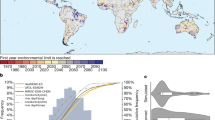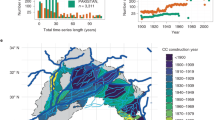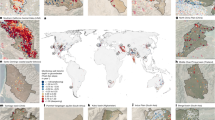Abstract
Over the past 50 years, humans have extracted the Earth’s groundwater stocks at a steep rate, largely to fuel global agro-economic development. Given society’s growing reliance on groundwater, we explore ‘peak water limits’ to investigate whether, when and where humanity might reach peak groundwater extraction. Using an integrated global model of the coupled human–Earth system, we simulate groundwater withdrawals across 235 water basins under 900 future scenarios of global change over the twenty-first century. Here we find that global non-renewable groundwater withdrawals exhibit a distinct peak-and-decline signature, comparable to historical observations of other depletable resources (for example, minerals), in nearly all (98%) scenarios, peaking on average at 625 km3 yr−1 around mid-century, followed by a decline through 2100. The peak and decline occur in about one-third (82) of basins, including 21 that may have already peaked, exposing about half (44%) of the global population to groundwater stress. Most of these basins are in countries with the highest current extraction rates, including the United States, Mexico, Pakistan, India, China, Saudi Arabia and Iran. These groundwater-dependent basins will probably face increasing costs of groundwater and food production, suggesting important implications for global agricultural trade and a diminished role for groundwater in meeting global water demands during the twenty-first century.
This is a preview of subscription content, access via your institution
Access options
Access Nature and 54 other Nature Portfolio journals
Get Nature+, our best-value online-access subscription
$29.99 / 30 days
cancel any time
Subscribe to this journal
Receive 12 digital issues and online access to articles
$119.00 per year
only $9.92 per issue
Buy this article
- Purchase on Springer Link
- Instant access to full article PDF
Prices may be subject to local taxes which are calculated during checkout




Similar content being viewed by others
Data availability
The large-ensemble data repository contains relevant model outputs from 900 scenarios simulated using GCAM59. The data repository is to be used in combination with the meta-repository containing scripts and files for reproducing the experiment as well as for the analysis and post-processing of the model outputs60.
Code availability
The meta-repository containing and explaining usage of code, modelling files and input data could be accessed to reproduce experiments, results and visualizations presented in this study60.
References
Abbott, B. W. et al. Human domination of the global water cycle absent from depictions and perceptions. Nat. Geosci. 12, 533–540 (2019).
Qin, Y. et al. Flexibility and intensity of global water use. Nat. Sustain. 2, 515–523 (2019).
Postel Sandra, L., Daily Gretchen, C. & Ehrlich Paul, R. Human appropriation of renewable fresh water. Science 271, 785–788 (1996).
Vörösmarty Charles, J., Green, P., Salisbury, J. & Lammers Richard, B. Global water resources: vulnerability from climate change and population growth. Science 289, 284–288 (2000).
Oki, T. & Kanae, S. Global hydrological cycles and world water resources. Science 313, 1068–1072 (2006).
Gleick, P. H. Transitions to freshwater sustainability. Proc. Natl Acad. Sci. USA 115, 8863–8871 (2018).
Liu, L. et al. Quantifying the potential for reservoirs to secure future surface water yields in the world’s largest river basins. Environ. Res. Lett. 13, 044026 (2018).
Aeschbach-Hertig, W. & Gleeson, T. Regional strategies for the accelerating global problem of groundwater depletion. Nat. Geosci. 5, 853–861 (2012).
Gleeson, T., Cuthbert, M., Ferguson, G. & Perrone, D. Global groundwater sustainability, resources, and systems in the Anthropocene. Annu. Rev. Earth Planet. Sci. 48, 431–463 (2020).
Wada, Y. & Bierkens, M. F. P. Sustainability of global water use: past reconstruction and future projections. Environ. Res. Lett. 9, 104003 (2014).
Rodell, M., Velicogna, I. & Famiglietti, J. S. Satellite-based estimates of groundwater depletion in India. Nature 460, 999–1002 (2009).
Wada, Y., van Beek, L. P. H. & Bierkens, M. F. P. Nonsustainable groundwater sustaining irrigation: a global assessment. Water Resour. Res.https://doi.org/10.1029/2011WR010562 (2012).
Famiglietti, J. S. The global groundwater crisis. Nat. Clim. Change 4, 945–948 (2014).
Konikow, L. F. & Kendy, E. Groundwater depletion: a global problem. Hydrogeol. J. 13, 317–320 (2005).
Siebert, S. et al. Groundwater use for irrigation—a global inventory. Hydrol. Earth Syst. Sci. 14, 1863–1880 (2010).
Grogan, D. S., Wisser, D., Prusevich, A., Lammers, R. B. & Frolking, S. The use and re-use of unsustainable groundwater for irrigation: a global budget. Environ. Res. Lett. 12, 034017 (2017).
Aquastat Database (FAO, accessed 5 June 2022); https://www.fao.org/nr/water/aquastat/data/query/index.html?lang=en
Dalin, C., Wada, Y., Kastner, T. & Puma, M. J. Groundwater depletion embedded in international food trade. Nature 543, 700–704 (2017).
Gleeson, T., Wada, Y., Bierkens, M. F. P. & van Beek, L. P. H. Water balance of global aquifers revealed by groundwater footprint. Nature 488, 197–200 (2012).
Dolan, F. et al. Evaluating the economic impact of water scarcity in a changing world. Nat. Commun. 12, 1915 (2021).
Birnbaum, A., Lamontagne, J., Wild, T., Dolan, F. & Yarlagadda, B. Drivers of future physical water scarcity and its economic impacts in Latin America and the Caribbean. Earths Future 10, e2022EF002764 (2022).
Seppelt, R., Manceur, A. M., Liu, J., Fenichel, E. P. & Klotz, S. Synchronized peak-rate years of global resources use. Ecol. Soc. 10.5751/ES-07039-190450 (2014).
Hubbert, M. K. Nuclear Energy and the Fossil Fuels Vol. 95 (Shell Development Company, Exploration and Production Research Division, 1956); http://www.energycrisis.com/Hubbert/1956/1956.pdf
Meinert, L. D., Robinson, G. R. & Nassar, N. T. Mineral resources: reserves, peak production and the future. Resources https://doi.org/10.3390/resources5010014 (2016).
Ericsson, M. & Söderholm, P. Mineral Depletion and Peak Production 222–231 (Palgrave Macmillan, 2013);https://doi.org/10.1057/9781137349149_12
Gleick, P. H. & Palaniappan, M. Peak water limits to freshwater withdrawal and use. Proc. Natl Acad. Sci. USA 107, 11155–11162 (2010).
Turner, S. W. D., Hejazi, M., Yonkofski, C., Kim, S. H. & Kyle, P. Influence of groundwater extraction costs and resource depletion limits on simulated global nonrenewable water withdrawals over the twenty-first century. Earths Future 7, 123–135 (2019).
Calvin, K. et al. Gcam v5.1: representing the linkages between energy, water, land, climate, and economic systems. Geosci. Model Dev. 12, 677–698 (2019).
Gleeson, T. et al. The water planetary boundary: interrogation and revision. One Earth 2, 223–234 (2020).
Graham, N. T. et al. Future changes in the trading of virtual water. Nat. Commun. 11, 3632 (2020).
Riahi, K. et al. The shared socioeconomic pathways and their energy, land use, and greenhouse gas emissions implications: an overview. Glob. Environ. Change 42, 153–168 (2017).
van Vuuren, D. P. et al. The representative concentration pathways: an overview. Clim. Change 109, 5 (2011).
Scanlon, B. R. et al. Global models underestimate large decadal declining and rising water storage trends relative to GRACE satellite data. Proc. Natl Acad. Sci. USA 115, E1080–E1089 (2018).
Perrone, D. & Jasechko, S. Deeper well drilling an unsustainable stopgap to groundwater depletion. Nat. Sustain. 2, 773–782 (2019).
Gleeson, T., Befus, K. M., Jasechko, S., Luijendijk, E. & Cardenas, M. B. The global volume and distribution of modern groundwater. Nat. Geosci. 9, 161–167 (2016).
de Graaf, I. E. M. et al. A global-scale two-layer transient groundwater model: development and application to groundwater depletion. Adv. Water Resour. 102, 53–67 (2017).
Konikow, L. F. Contribution of global groundwater depletion since 1900 to sea-level rise. Geophys. Res. Lett. https://doi.org/10.1029/2011GL048604 (2011).
Wada, Y. et al. Global depletion of groundwater resources. Geophys. Res. Lett. https://doi.org/10.1029/2010GL044571 (2010).
Huang, Z. et al. Global agricultural green and blue water consumption under future climate and land use changes. J. Hydrol. 574, 242–256 (2019).
Fitton, N. et al. The vulnerabilities of agricultural land and food production to future water scarcity. Glob. Environ. Change 58, 101944 (2019).
Turner, S. W. D., Hejazi, M., Calvin, K., Kyle, P. & Kim, S. A pathway of global food supply adaptation in a world with increasingly constrained groundwater. Sci. Total Environ. 673, 165–176 (2019).
van Vuuren, D. P. et al. The shared socio-economic pathways: trajectories for human development and global environmental change. Glob. Environ. Change 42, 148–152 (2017).
O’Neill, B. C. et al. The roads ahead: narratives for shared socioeconomic pathways describing world futures in the 21st century. Glob. Environ. Change 42, 169–180 (2017).
Graham, N. T. et al. Water sector assumptions for the shared socioeconomic pathways in an integrated modeling framework. Water Resour. Res. 54, 6423–6440 (2018).
Hejazi, M. I. et al. Integrated assessment of global water scarcity over the 21st century under multiple climate change mitigation policies. Hydrol. Earth Syst. Sci. 18, 2859–2883 (2014).
Hejazi, M. I. et al. 21st century United States emissions mitigation could increase water stress more than the climate change it is mitigating. Proc. Natl Acad. Sci. USA 112, 10635–40 (2015).
Heistermann, M. Hess opinions: a planetary boundary on freshwater use is misleading. Hydrol. Earth Syst. Sci. 21, 3455–3461 (2017).
Rockström, J. et al. Future water availability for global food production: the potential of green water for increasing resilience to global change. Water Resour. Res. https://doi.org/10.1029/2007WR006767 (2009).
Jägermeyr, J., Pastor, A., Biemans, H. & Gerten, D. Reconciling irrigated food production with environmental flows for sustainable development goals implementation. Nat. Commun. 8, 15900 (2017).
D’Odorico, P. et al. The global food–energy–water nexus. Rev. Geophys. 56, 456–531 (2018).
Wada, Y. et al. Modeling global water use for the 21st century: Water Futures and Solutions (WFAS) initiative and its approaches. Geosci. Model Dev. 9, 175–222 (2016).
Byers, E. et al. Global exposure and vulnerability to multi-sector development and climate change hotspots. Environ. Res. Lett. 13, 055012 (2018).
Miralles-Wilhelm, F. Water is the middle child in global climate policy. Nat. Clim. Change 12, 110–112 (2022).
Gleick, P. H. Global freshwater resources: soft-path solutions for the 21st century. Science 302, 1524–1528 (2003).
Zhao, X., Calvin, K. V., Wise, M. A. & Iyer, G. The role of global agricultural market integration in multiregional economic modeling: using hindcast experiments to validate an Armington model. Econ. Anal. Policy 72, 1–17 (2021).
Bryant, B. P. & Lempert, R. J. Thinking inside the box: a participatory, computer-assisted approach to scenario discovery. Technol. Forecast. Soc. Change 77, 34–49 (2010).
Gleeson, T. et al. GMD perspective: the quest to improve the evaluation of groundwater representation in continental- to global-scale models. Geosci. Model Dev. 14, 7545–7571 (2021).
Wada, Y. et al. Human–water interface in hydrological modelling: current status and future directions. Hydrol. Earth Syst. Sci. 21, 4169–4193 (2017).
Niazi, H. et al. Large ensemble dataset for discovering global peak water limit of future groundwater withdrawals using 900 GCAM runs. Zenodo https://doi.org/10.5281/zenodo.6480465 (2023).
Niazi, H. Meta-repository for groundwater peak and decline: JGCRI/niazi-etal_2024_nature-sustainability: v1-accepted. Zenodo https://doi.org/10.5281/zenodo.10524993 (2024).
Kim, S. H. et al. Balancing global water availability and use at basin scale in an integrated assessment model. Clim. Change 136, 217–231 (2016).
Hejazi, M. et al. Long-term global water projections using six socioeconomic scenarios in an integrated assessment modeling framework. Technol. Forecast. Soc. Change 81, 205–226 (2014).
Liu, Y., Hejazi, M., Li, H., Zhang, X. & Leng, G. A hydrological emulator for global applications—HE v1.0.0. Geosci. Model Dev. 11, 1077–1092 (2018).
Vernon, C. R. et al. A global hydrologic framework to accelerate scientific discovery. J. Open Res. Softw. 10.5334/jors.245 (2019).
Richts, A., Struckmeier, W. F. & Zaepke, M. WHYMAP and the Groundwater Resources Map of the World 1:25,000,000 159–173 (Springer, 2011); https://doi.org/10.1007/978-90-481-3426-7_10
Gleeson, T., Moosdorf, N., Hartmann, J. & van Beek, L. P. H. A glimpse beneath earth’s surface: GLobal HYdrogeology MaPS (GLHYMPS) of permeability and porosity. Geophys. Res. Lett. 41, 3891–3898 (2014).
de Graaf, I. E. M., Sutanudjaja, E. H., van Beek, L. P. H. & Bierkens, M. F. P. A high-resolution global-scale groundwater model. Hydrol. Earth Syst. Sci. 19, 823–837 (2015).
Fan, Y., Li, H. & Miguez-Macho, G. Global patterns of groundwater table depth. Science 339, 940–943 (2013).
Kyle, P. et al. Assessing the future of global energy-for-water. Environ. Res. Lett. 16, 024031 (2021).
Cui, R. Y. et al. Regional responses to future, demand-driven water scarcity. Environ. Res. Lett. 13, 094006 (2018).
Liu, L., Hejazi, M., Iyer, G. & Forman, B. A. Implications of water constraints on electricity capacity expansion in the United States. Nat. Sustain. 2, 206–213 (2019).
Giuliani, M., Lamontagne, J. R., Hejazi, M. I., Reed, P. M. & Castelletti, A. Unintended consequences of climate change mitigation for African river basins. Nat. Clim. Change 12, 187–192 (2022).
Lempert, R. J. A new decision sciences for complex systems. Proc. Natl Acad. Sci. USA 99, 7309–7313 (2002).
Lamontagne, J. R. et al. Large ensemble analytic framework for consequence-driven discovery of climate change scenarios. Earths Future 6, 488–504 (2018).
Warszawski, L. et al. The Inter-Sectoral Impact Model Intercomparison Project (ISI–MIP): project framework. Proc. Natl Acad. Sci. USA 111, 3228–3232 (2014).
Turner, S. W., Ng, J. Y. & Galelli, S. Examining global electricity supply vulnerability to climate change using a high-fidelity hydropower dam model. Sci. Total Environ. 590, 663–675 (2017).
Schewe, J. et al. Multimodel assessment of water scarcity under climate change. Proc. Natl Acad. Sci. USA 111, 3245–3250 (2014).
Rosenzweig, C. et al. Assessing agricultural risks of climate change in the 21st century in a global gridded crop model intercomparison. Proc. Natl Acad. Sci. USA 111, 3268–3273 (2014).
Clarke, L. et al. Effects of long-term climate change on global building energy expenditures. Energy Econ. 72, 667–677 (2018).
Döll, P., Müller Schmied, H., Schuh, C., Portmann, F. T. & Eicker, A. Global‐scale assessment of groundwater depletion and related groundwater abstractions: combining hydrological modeling with information from well observations and GRACE satellites. Water Resour. Res. 50, 5698–5720 (2014).
Hanasaki, N., Yoshikawa, S., Pokhrel, Y. & Kanae, S. A global hydrological simulation to specify the sources of water used by humans. Hydrol. Earth Syst. Sci. 22, 789–817 (2018).
Pokhrel, Y. N. et al. Model estimates of sea-level change due to anthropogenic impacts on terrestrial water storage. Nat. Geosci. 5, 389–392 (2012).
Pokhrel, Y. N. et al. Incorporation of groundwater pumping in a global Land Surface Model with the representation of human impacts. Water Resour. Res. 51, 78–96 (2015).
van Dijk, A. I. J. M., Renzullo, L. J., Wada, Y. & Tregoning, P. A global water cycle reanalysis (2003–2012) merging satellite gravimetry and altimetry observations with a hydrological multi-model ensemble. Hydrol. Earth Syst. Sci. 18, 2955–2973 (2014).
Wada, Y. Past and future contribution of global groundwater depletion to sea‐level rise. Geophys. Res. Lett. 39, L09402 (2012).
Yoshikawa, S., Cho, J., Yamada, H. G., Hanasaki, N. & Kanae, S. An assessment of global net irrigation water requirements from various water supply sources to sustain irrigation: rivers and reservoirs (1960–2050). Hydrol. Earth Syst. Sci. 18, 4289–4310 (2014).
Bierkens, M. F. P. & Wada, Y. Non-renewable groundwater use and groundwater depletion: a review. Environ. Res. Lett. 14, 063002 (2019).
Acknowledgements
This research was supported by the U.S. Department of Energy, Office of Science, as part of research in MultiSector Dynamics of the Earth and Environmental System Modeling Program. The Pacific Northwest National Laboratory is operated for the DOE by Battelle Memorial Institute under contract DE-AC05-76RL01830. Authors M.H., S.T. and S.M. primarily contributed to this work while at the Pacific Northwest National Laboratory. The views and opinions expressed in this paper are those of the authors alone and should not be construed to represent any official USDA, USDOE or US Government determination or policy.
Author information
Authors and Affiliations
Contributions
All authors contributed to this study. M.H. and S.T. conceptualized the study. H.N., S.T., T.W. and N.G. conducted modelling and analysis, including designing scenario experiments, analysing GCAM modelling outputs and visualizing results, and all authors contributed towards the writing of the paper.
Corresponding author
Ethics declarations
Competing interests
The authors declare no competing interests.
Peer review
Peer review information
Nature Sustainability thanks Marc Bierkens, Inge de Graaf and the other, anonymous, reviewer(s) for their contribution to the peer review of this work.
Additional information
Publisher’s note Springer Nature remains neutral with regard to jurisdictional claims in published maps and institutional affiliations.
Supplementary information
Supplementary Information
Supplementary Figs. 1–24, Supplementary Tables 1–8, equations 1–4, 44 additional literature references and links to a publicly accessible meta-repository of data and code: https://github.com/JGCRI/niazi-etal_2024_nature-sustainability.
Rights and permissions
Springer Nature or its licensor (e.g. a society or other partner) holds exclusive rights to this article under a publishing agreement with the author(s) or other rightsholder(s); author self-archiving of the accepted manuscript version of this article is solely governed by the terms of such publishing agreement and applicable law.
About this article
Cite this article
Niazi, H., Wild, T.B., Turner, S.W.D. et al. Global peak water limit of future groundwater withdrawals. Nat Sustain 7, 413–422 (2024). https://doi.org/10.1038/s41893-024-01306-w
Received:
Accepted:
Published:
Issue Date:
DOI: https://doi.org/10.1038/s41893-024-01306-w



